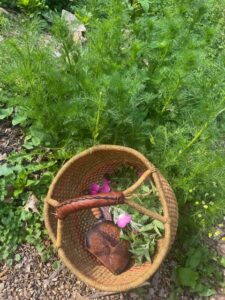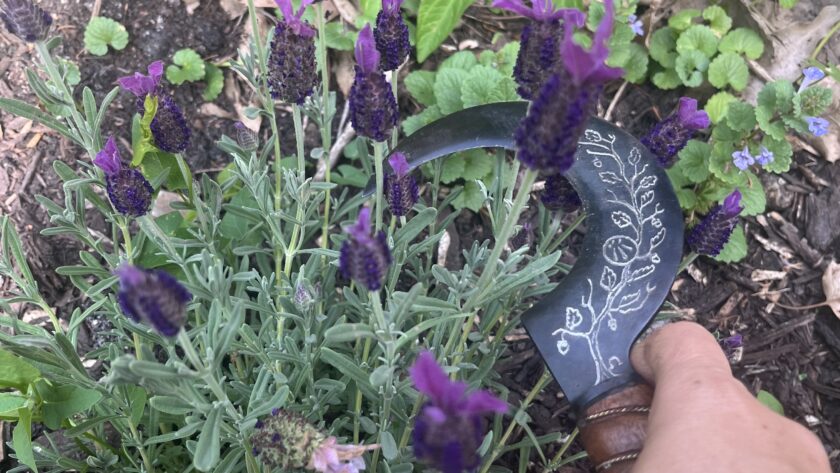Walking through a sacred garden or a wild place always brings such joy; working with the herbs, drawing their wisdom, and seeing which herbs reach out for healing and health. Today, in honor of the upcoming Summer Solstice, I will offer a simple practice that you can do to observe the summer solstice, the longest day of the year.
Sun teas have a warm place in my heart. When I was a child, my mother used to go out to the garden with her scissors and walk through the paths, selecting which herbs she wanted to use for the day. Then she’d put the herbs along with a tea bag or two in a large mason jar and sit it out on the porch all day to gather up the rays of the sun. Almost every day, she had some sun tea brewing, which we would then enjoy with ice on a hot summer’s day. This practice, more ritualized, stems from these early childhood experiences. Rituals don’t have to be complex or formal, they can be simple practices that we repeat and that build meaning. A summer magical sun tea is exactly such a practice. This is a simple ritual, intuitive, built into life, without any fancy clothes or scripts.
For other Summer Solstice options for celebration and observation, you can see my previous posts: ReVisioning at the Summer Solstice, Summer Solstice Observation Ceremony, Summer Solstice Journey and Ritual of Illumination, Sacred Beekeeping at the Summer Solstice, and Spiritual and Sustainable Practices for the Summer Solstice.
A Sacred Solstice Walk

The first part of this involves a walk where you take the time to commune with nature, honor the plants and trees, find herbal medicines that speak to you, and reciprocate their generosity with an offering. You can go anywhere and find plants to make a tea: your own garden or a local community garden, a wild area, a park and so forth. Going into the wilds assumes you have a basic knowledge of wild food and wild medicine foraging. Being in your own garden or a community garden with labels makes things easier because you know the different teas you planted.
The basic practice is very simple: take a basket and some pruners and go to the space. Say a prayer for whatever healing or intentions you desire, and make an offering to the spirits of the land to help you find the right healing blend of herbs. Then, simply do a meditative walk through the space, putting out the prayer and intention for sacred herbal healing. See which plants speak to you. Whatever plant calls out, spend some time just connecting to that plant both physically and metaphysically: use your five senses to experience the plant. Use your intuition and spirit communication to hear the plant’s wisdom and experience their deeper teachings. If you feel led and have permission, harvest a bit of the plant for your solstice healing tea. If you have a sickle or special knife, all the better.

Some ideas from my part of the world are as follows: Garden herbs that make good tea are bountiful and include lemon balm, rhubarb stalks, various kinds of mint, raspberry leaves, mullein, monarda, sages, nettle, oregano, lemongrass, sweetgrass, and rose (hips, flowers, leaves). Lawn plants (in unsprayed lawns) also work wonderfully well for tea such as all heal, ground ivy, dandelion leaf or root, dead nettle, plantain, burdock root, or chickweed.
If you go out for a walk in a wild area, invariably, there are trees and plants that you can use for tea. Look to many conifers here–white pine, norway spruce, and eastern hemlock are a few of the conifers that make an outstanding tea. Other tree teas include linden in flower, stinging nettle, wild strawberry leaf, goldenrod leaf, wild ox-eye daisy leaf and petals, mugwort, and spicebush leaves. There are so many different plants that you can meet and use and part of the joy of this practice is building your knowledge of plants over time.
Alternatives to the Herb Walk: Apothecary or Farmer’s Market Approach

Perhaps you don’t have access to a sacred garden in a public or private place but you still want to do this practice–there are so many alternatives! One is to lay out all of the herbs you have access to (e.g. pull them out of their bags, jars, etc) and then sit comfortably with them around you. Pray to the herbs, asking for their guidance and healing energy. Then see which come to you, which you are drawn to, and make an intuitive blend of those herbs.
Another alternative is to go to a local farmer’s market, which often sells bundles of fresh cut herbs. Spend time with the different herbs available and see which speak to you.
Brewing Your Solstice Tea

Now that your herbs are collected, you can brew your tea. You can brew it on any sunny day around the solstice (or even for the weeks leading up to the solstice). To do so, loosely chop your herbs. Place your herbs in a large mason jar (I like to use a 1/2 gallon jar) and then sit them in the sun for at least a few hours. Strain, add honey or maple syrup or whatever other sweetener you like.
Note that if you can’t brew right away, you can let them wilt on your counter for a day or two (this will not hurt the herbs).
Enjoying your Solstice Tea: Sunrise and Sunset

I like to use tea as part of my meditative practice, and for the solstice, which typically involves observing sunrise and sunset (see more solstice practices here with the sun). Take your tea to a place where you can observe the sunrise or sunset, or simply sit in the sun. Drink your tea and simply take in the world around you. Pay attention to how the tea makes you feel–energized? Calm? Pain free? Do any other work you’d like surrounding your tea.
The tea I made when writing this post was: thyme, apothecary rose, mugwort, mint, rose leaf, and chamomile. It was wonderful after brewing in the greenhouse all day!
While everything I described is a very simple way to celebrate the solstice, I like it because of the simplicity. the longer that I walk the druid path, the more that I value these kinds of more simple, unscripted and intuitive practices to connect with the land, the spirits, and the world around me. Blessings of the summer solstice!




Thank you for this post, i can’t wait to create some of my own Solstice Healing Tea! I also love the fact that you provide alternatives ways for collecting herbs such as the farmers market for those of us not fortunate enough to have a garden.
Hi Sharon, thanks for your comments! I hope you enjoy your solstice tea :).
You forgot to mention mulberry leave as good for tea – both white & black mulberries can be used.
Sure, Mulberry are great. I actually don’t have any in my region, so I often forget about them. Thanks fro the reminder!
Practical question (sorry if it’s a silly one): do you put cold water on your herbs and let the sun warm them to infuse? Or do you pour on hot water (like making standard tea)?
Hi Nicola,
I don’t think it matters on a really warm sunny day but it might on a cloudy day. The water will obviously warm faster if you start with warmer water. So, I usually use warm water from my tap (we have a spring here). I hope that helps!
Thanks for your question and for reading!